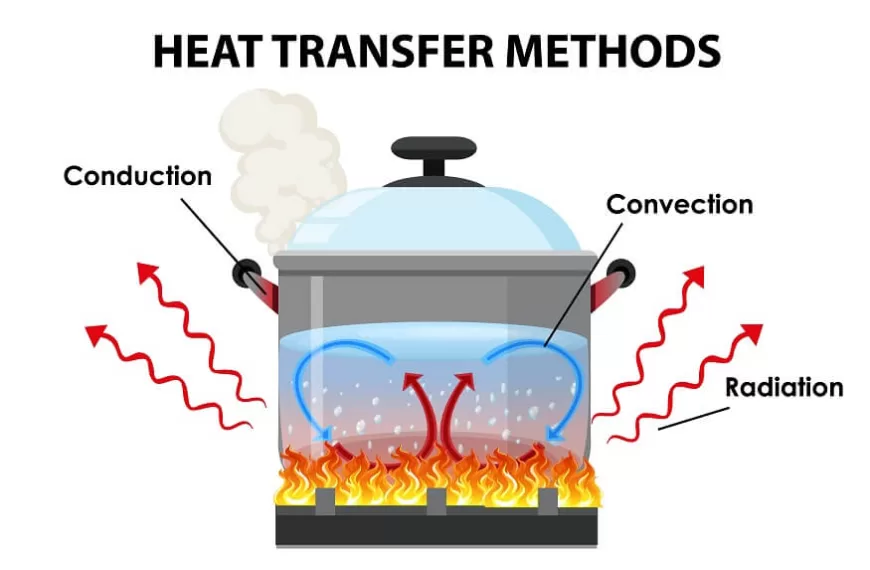In the evolving world of science, heat transfer is an interesting phenomenon for kids. It studies how heat moves from one place to another. This transfer occurs because heat naturally flows from warmer objects to cooler ones. Well, you can easily observe heat transfer all around you, see whether you are drinking a warm cup of coffee or feeling the heat of the sun on your face, the process of heat transfer continues to work. In this blog post, we will be digging through the fundamentals of heat transfer and its various methods. At the end, we will also be discussing some interesting frequently asked questions related to heat transfer and its various methods for kids.
How Does Heat Transfer Work?
The process through which thermal energy is converted from one substance to another is known as heat transfer. This movement of heat can occur through multiple methods. As we see things become warm or cold due to the below three methods of heat transfer.
The Three Methods of Heat Transfer
Heat can move through three basic methods: conduction, convection, and radiation. Let us understand each of them with some everyday examples.
Conduction:
Conduction is the simple method of heat transfer through direct contact between objects in the universe. The better the conductor, the faster heat energy will transfer. There are different kinds of good conductors namely copper, iron, silver, steel, etc. Also, there are some lousy conductors which are known as insulators. This includes wood, paper, air, etc.
Examples of Conduction from Everyday Life:
- Imagine holding a hot potato in your hand. The heat from the potato passes into your hand through direct contact as a result making it warm.
- When you cook pancakes on a hot griddle, the warmth from the griddle is transmitted to the pancake batter through direct contact. This makes the batter solidify and turn into delicious pancakes.
Convection:
Convection is a method of heat transfer through the movement of liquids and gases. Due to its decrease in density, a heated gas or liquid warms up, expands, and rises. When the gas or liquid cools down, it becomes thicker and falls. A convection current is formed when temperatures rise and fall. This is the primary way heat moves through liquids and gases.
Examples of Convection from Everyday Life:
- When you boil water in a pan, the heat from the bottom, the water turns out. As it goes up, cooler water takes its place, making a circular movement of heat transfer.
- If you have ever stayed near a room heater on a cold day, you must have experienced convection. You will feel warm because the heater warms the air in the area around you, causing it to change in temperature and move throughout the room.
Radiation:
Radiation is another method of heat transfer in which heat is transferred with the help of electromagnetic waves. It is warmth that is moving in the form of light, sometimes it is visible and sometimes invisible. It does not need anything to travel through; as it can move freely through empty space.
Examples of Radiation from Everyday Life:
- When you use a microwave oven to heat your leftovers, it uses radiation to transfer heat directly to your food, making it piping hot and ready to eat.
- Radiation from the sun also represents heat. The Earth receives sunshine, which warms the surface and makes it best for outdoor activities.
Conclusion
It is interesting and a great learning experience to comprehend how heat transfer operates. It enables us to keep warm, cook our favourite food, and soak up the heat of the sun. So, next time you hold a hot potato, stand by a room heater or enjoy the sunshine, you will easily understand how exactly heat is being transmitted. As we nurture the interest of young minds, it is essential to provide them with an environment that encourages the pursuit of knowledge.
That’s where Eurokids comes in. The mission of Eurokids is to give a loving and stimulating educational experience to kids. So, if you are looking for a place where your child can learn and grow while having fun, come to Eurokids for a rewarding educational experience. It’s time to keep your curiosity alive and continue exploring the world of science with Eurokids.
Visit us today for an enriching educational experience for your kids!
Frequently Asked Questions on Heat Transfer and its Various Methods:
- Is heat transfer only about making things hot?
- Which kind of heat transfer is the cause of the increase in the temperature of the Earth?
- How do insulators and conductors affect the transfer of heat?
- Can heat transfer occur in a vacuum?
- What can prevent the transfer of heat?
- Is it possible to measure the transfer of heat in units?
Ans. No, heat transfer can also make things cooler. For example, when you put an ice pack on your forehead, it soaks up the heat from your skin as a result makes you feel cooler, it is nothing but transfer of heat.
Ans. Yes, the Earth is becoming warmer as a result of radiation. Heat energy from the Sun is absorbed by the Earth and is becoming warmer resulting in the temperature rise.
Ans. Insulators are materials that resist the flow of heat, keeping things warm or cold. Conductors, on the other hand, are materials that facilitate heat transfer, making things heat up or cool down quickly.
Ans. Yes, heat transfer can occur in a vacuum, but it mostly happens through radiation. Space is a vacuum, however, the heat of the Sun reaches us on Earth through the radiation of energy in the form of sunlight.
Ans. The transfer of heat energy can be prevented by an insulating component. For example, using a thermos flask, heat cannot enter or leave the interior or exterior of the object.
Ans. Yes, the transfer of heat can be measured using a unit called “calories” or “joules.” Scientists use calorimeters to measure the quantity of heat transferred during various activities.















